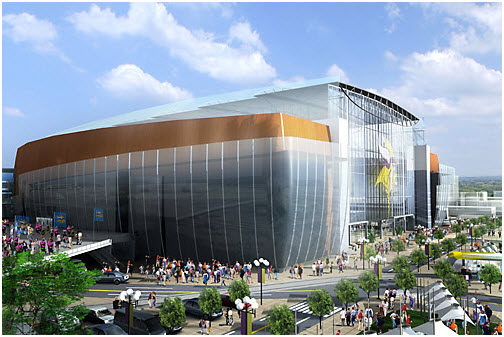It should be about people
The author of this post, Nathaniel Hood, is a Strong Towns partner. In addition to contributing to this site, you can read Nate's work at his blog, Thoughts on the Urban Environment, and at the new Minnesota-based transportation site Streets.MN. You can also follow him on Twitter.
For a place to be successful, it needs people. All types of people. This is why the idea of creating “entertainment districts” might not be such a great idea.
Proposals for entertainment districts occasionally sprout up in City Councils meetings as the next big thing. While it certainly is tempting in its efforts to capitalize on people’s passion for retail, sports, food and drink; it is a development prospect that should be viewed with skepticism.

This is a rendering of one proposed Vikings stadium; one that was slated to be part of a “sports entertainment district” in downtown Minneapolis. Sports entertainment is a large element in selling these districts, and fair enough, sports are something we value in our culture and it makes subsidizing these projects somewhat more tolerable to the general public. But is it worth it for the urban spaces they create?
In Minnesota, “the best stadium site got snubbed,” at least according to Steve Berg in the Star Tribune:
Perhaps we’ve just witnessed the ultimate NIMBY encounter: America’s two most powerful religions squaring off against each other, with Christianity telling the National Football League: Not in my back yard! Build a Vikings stadium if you must, but not next door to the Basilica of St. Mary. [Star Tribune, January 26, 2012]
In the article, Berg’s arguments refuting Basilica of St. Mary’s Rev. John Bauer’s aren’t necessarily wrong. In fact, he points out holes in Rev. Bauer’s objections to the Linden Avenue site. Yet, none of this matters because Berg’s vision is, ironically, antithetical to his greater aspiration for Minneapolis urbanism.
Berg wants to create a sports entertainment district centered around Target Field, a new Vikings stadium and the renovated Target Center. This is a misguided effort to create a place not worth being in. In my opinion, instead of asking how we could fund an entertainment district, we should be asking ourselves: do we even want an entertainment district?
Why? Because they lack the most crucial element of creating great places: people.
While entertainment districts certainly have people during the odd event, they are otherwise deserts of large infrastructure investments. Don’t believe me? Check out examples of entertainment districts across the county in Cincinnati, Phoenix, Des Moines, Philadelphia, Pittsburgh, and even the so-called successes of Denver (here & here) and Los Angeles.
Entertainment districts, even the best ones, fail at creating a lively mix of retail, residential, commercial and civic space. In fact, most all mega projects have failed in this regard. They are isolating locations, usually not worthy of the public affection beyond the handful of large sporting events, conventions or Friday night bar excursions. In fact, show me an existing or proposed entertainment district and I’ll show you a struggling city.
Large and mid-size towns have started to classify downtown’s as entertainment districts. This is a dangerous precedent to set and often times contradictory to Strong Towns place making principles. Kansas City’s Power and Light District comes to mind. It’s hard not to argue that the area is charming, fun, exciting and a few other hedonistic adjectives. It’s all of these things … if you’re 25. But, unfortunately, these types of environments don’t help in attracting other sorts into the urban settings; baby boomers and families with young children aren’t going to be attracted to these places.
That’s not to say that the activities that take place in the Power and Light District should be regulated or banned. Nor do I want to imply that sports stadiums don’t have a place in our urban environment. But, what I’m attempting to say is that downtowns need to be a place for everyone. Entertainment districts don’t do a good job that, and they certainly don’t offer good urban outcomes – often times they replicate the same symptoms of urban malls.
Paris and Florence don’t have entertainment district. Neither does San Francisco. Melbourne doesn’t either. What these cities have are spaces for people. They also have sports stadiums and bars – just not as the focal points of their city centers.
When a large building fails at creating a lively mix of retail, residential, commercial and civic space – it creates an isolating space not worthy of the public affection. It doesn’t help that these places aren’t cheap – taxpayers usually end up taking on the initial bill, and all the risk. Entertainment districts are the new “Bilbao anomaly” are the new urban mall, are the downtown casino, the list goes on. Regardless, at the end of the day, strong towns don’t create “entertainment districts”, they should create places.
If you value our work, please consider making a tax-deductible donation to support this blog and our other efforts to build a stronger, more resilient America. A small, recurring donation by you will help us in so many ways. Thank you for your support.
